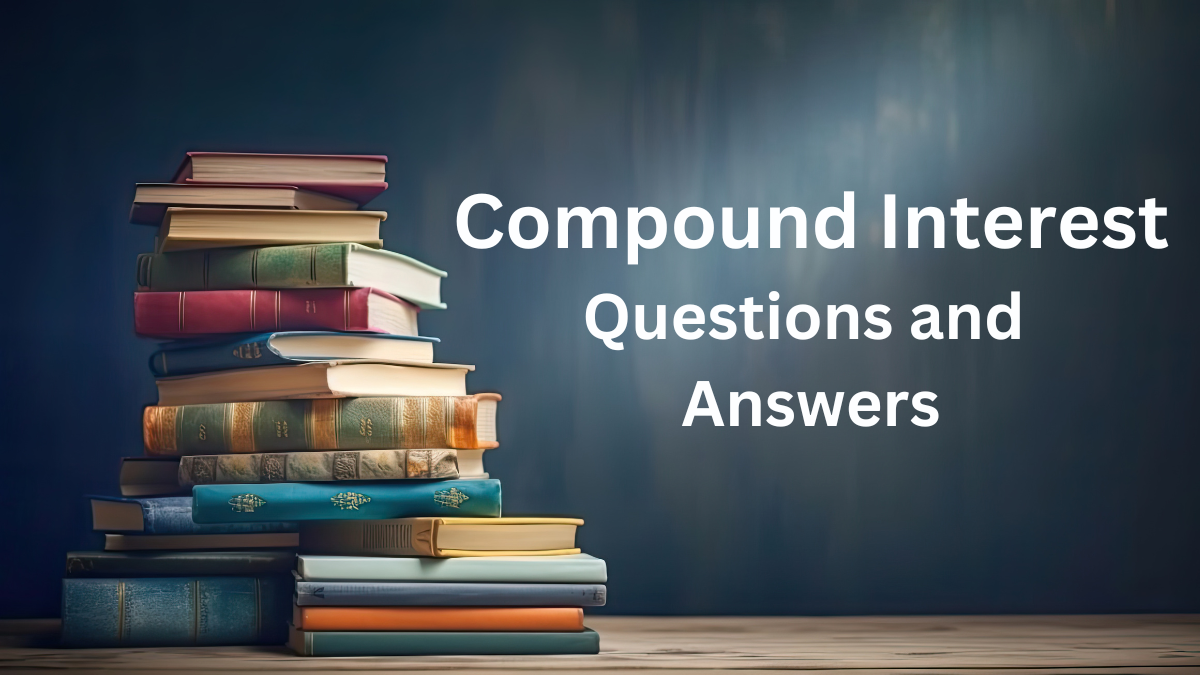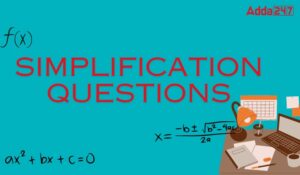Table of Contents
Compound Interest is an important concept with broad applications in real-life scenarios and is a prominent component of quantitative aptitude sections in major bank exams, including IBPS PO, IBPS Clerk, SBI PO, SBI Junior Associate, RRB Clerk, RRB Scale 1 Officer, and LIC Assistant exam. This topic holds significant importance for aspiring bankers due to its significant role in financial transactions and investments. BankersAdda offers a compilation of important memory-based Compound Interest questions with answers from past exams, along with Compound Interest Questions PDF that you can conveniently download and practice for your upcoming exams.
What is Compound Interest?
Compound interest is the addition of interest to the principal sum of a loan or deposit. It is the outcome of reinvesting interest rather than paying it out so that interest is received on the principal plus previously collected interest in the next period.
Compound interest questions are provided here to help the students understand the applications of compound interest in our daily existence. As we know, compound interest is one of the important mathematical concepts that can be applied in many financial transactions.
Below are some situations where we can use the formula of CI to calculate the required results.
- Increase or decrease in population
- The growth of a bacteria (when the rate of growth is known)
- The value of an item, if its price increases or decreases in the intermediate years
Formula of Compound Interest?
Interest is the additional money paid by organisations like banks or post offices on money deposited (kept) with them. Interest is also paid by people when they borrow money. When the interest is calculated on the previous year’s amount, the interest is called compounded or Compound Interest (C.I.).
The formula for finding the amount on compound interest is given by:
A = P[1 +(R/100)]n
This is the amount when interest is compounded annually.
Compound interest (CI) = A – P
Compound Interest Questions and Answers
Question 1: A bank offers 5% compound interest calculated on half-yearly basis. A customer deposits Rs. 1600 each on 1st January and 1st July of a year. At the end of the year, the amount he would have gained by way of interest is:
A Rs. 120
B Rs. 121
C Rs. 122
D Rs. 123
Question 2: The difference between simple and compound interests compounded annually on a certain sum of money for 2 years at 4% per annum is Re. 1. The sum (in Rs.) is:
A. 625
B. 630
C. 640
D. 650
Question 3: There is 60% increase in an amount in 6 years at simple interest. What will be the compound interest of Rs. 12,000 after 3 years at the same rate?
A. Rs. 2160
B. Rs. 3120
C. Rs. 3972
D. Rs. 6240
Question 4: What is the difference between the compound interests on Rs. 5000 for 1 years at 4% per annum compounded yearly and half-yearly?
A. Rs. 2.04
B. Rs. 3.06
C. Rs. 4.80
D. Rs. 8.30
Question 5: What will be the compound interest on a sum of Rs. 25,000 after 3 years at the rate of 12 p.c.p.a.?
A. Rs. 9000.30
B. Rs. 9720
C. Rs. 10123.20
D. Rs. 10483.20
Question 6: At what rate of compound interest per annum will a sum of Rs. 1200 become Rs. 1348.32 in 2 years?
A. 6%
B. 6.5%
C. 7%
D. 7.5%
Question 7: The least number of complete years in which a sum of money put out at 20% compound interest will be more than doubled is:
A. 3
B. 4
C. 5
D. 6
Question 8: Albert invested an amount of Rs. 8000 in a fixed deposit scheme for 2 years at compound interest rate 5 p.c.p.a. How much amount will Albert get on maturity of the fixed deposit?
A. Rs. 8600
B. Rs. 8620
C. Rs. 8820
D. None of these
Question 9: The effective annual rate of interest corresponding to a nominal rate of 6% per annum payable half-yearly is:
A. 6.06%
B. 6.07%
C. 6.08%
D. 6.09%
Question 10: At what rate of compound interest per annum, a sum of Rs. 1200 becomes Rs. 1348.32 in 2 years?
A .6%
B. 7%
C 8%
D 9%
Question 11: Rahul invested a certain amount in three different schemes A, B, and C with the rate of interest 10% p.a., 12% p.a. and 15% p.a. respectively. If the total interest accrued in one year was Rs. 3200 and the amount invested in Scheme C was 150% of the amount invested in Scheme A and 240% of the amount invested in Scheme B, what was the amount invested in Scheme B?
A. Rs 5000
B. Rs 6500
C. Rs 8000
D. Rs 10000
Question 12: If a sum of Rs.8000 lended for 20% per annum at compound interest then the sum of the amount will be Rs.13824 in:
A. 2 years
B. 1 year
C. 3 years
D. 4 years
Question 13: Find the compound interest on a principal amount of Rs.5000 after 2 years, if the rate of interest for the 1st year is 2% and for the 2nd year is 4%.
A Rs.304
B. Rs.314
C. Rs.324
D. Rs.334
Question 14: What sum(principal) will be amount to Rs.34536.39 at compound interest in 3 years, the rate of interest for 1st, 2nd and 3rd year being 5%, 6% and 7% respectively?
A. Rs.25576
B. Rs.29000
C. Rs.28012
D. Rs.24000
Question 15: What will be the amount if sum of Rs.10,00,000 is invested at compound interest for 3 years with rate of interest 11%, 12% and 13% respectively?
A. Rs.14,04,816
B. Rs.12,14,816
C. Rs.11,35,816
D. Rs.16,00,816
Question 16: Compound interest is the adding of interest to the principal sum of a loan or deposit. It is the outcome of reinvesting interest rather than paying it out, so that interest is received on the principal plus previously collected interest in the next period.
A. 10
B. 15
C. 12
D. 8
Question 17: The difference between the compound interest and the simple interest on a sum for two years at 10% pa, when the interest is compounded yearly, is Rs 400. If the interest is compounded half-yearly, what will be the difference between the CI and the SI ?
A. Rs 400
B. Rs 525.50
C. Rs 620.25
D. Rs 640.50
Question 18: A and B each borrowed equal sums for 3 years at the rate of 5% simple and compound interest respectively. At the time of repayment B has to pay Rs. 76.25 more than A. The sum borrowed and the interest paid by A (in Rs.) is:
A. Rs. 10,000, Rs. 1,500
B. Rs. 11,000, Rs. 1,100
C. Rs. 10,000, Rs. 1,400
D. Rs. 9,000, Rs. 200
Question 19: A man borrows Rs. 6000 at 10% compound rate of interest. He pays back Rs. 2000 at the end of each year to clear his debt. The amount that he should pay to clear all his dues at the end of third year is:
A. Rs. 6000
B. Rs. 3366
C. Rs. 3060
D. Rs. 3066
Question 20: Rohit took a loan of Rs. 20000 to purchase one LCD TV set from a finance company. He promised to make the payment after three years. The company charges compound interest at the rate of 10% per annum for the same. But suddenly the company announces the rate of interest as 15% per annum for the last one year of the loan period. What extra amount does Rohit have to pay due to this announcement of the new rate of interest ?
A. Rs. 7830
B. Rs. 4410
C. Rs. 6620
D. Rs. 1210
| Answers | |||||||||
| 1. B | 3. C | 5. C | 7. B | 9. D | 11. A | 13. B | 15. C | 17.D | 19. B |
| 2. A | 4. A | 6. A | 8. C | 10. A | 12. C | 14. A | 16. C | 18. A | 20. D |




 Simplification Questions For Bank Exams ...
Simplification Questions For Bank Exams ...
 Quantity Comparison Questions for Bank E...
Quantity Comparison Questions for Bank E...
 Mixture & Alligation Questions for B...
Mixture & Alligation Questions for B...







